Discover top guides, trends, tips and expertise from AIO Writers
10 Best Content Marketing Analytics Tools of 2025
Jeff Joyce
Tuesday, 14th Jan 2025
As a former agency owner, I understand the challenges of balancing client demands, deadlines, and the constant need to justify your content marketing ROI. You need concrete data to support your strategy, not just intuition.
This is where a robust content marketing analytics tool proves invaluable — providing crucial insights into what’s effective and what’s not, and how to enhance your approach for better outcomes.
Let’s discuss how content marketing analytics work and how modern tools make it easier for today’s marketers to track and monitor their content’s performance. Plus, I’ll share with you my top recommendations for the best content analytics software for agencies.
Table Of Contents:
- What is Content Marketing Analytics?
- How Do You Analyze Content Marketing? 10 Key Metrics to Watch
- The Best Content Marketing Analytics Tools of 2025
- Elevate Your Client’s Brand in 2025 With These Right Content Marketing Analytics Tools
What is Content Marketing Analytics?
In simple terms, content analytics involves collecting and analyzing data regarding your content’s effectiveness. However, this goes beyond tracking superficial metrics such as page views. Content analytics shows you how your target audience engages with your content, what they find valuable, and ultimately, how content contributes to your overall business objectives.
Marketers and agencies today are under pressure to demonstrate accountability. Proving to your clients that your content is meeting their business goals requires you to show real numbers — hence the importance of tracking and analysis.
Also, algorithms, consumer behavior, and marketing technologies are constantly evolving. A top-notch content marketing analytics tool helps you remain adaptable and successful in the face of continuous change.
How Do You Analyze Content Marketing? 10 Key Metrics to Watch
When analyzing content performance, marketing agencies should focus on several key performance indicators (KPIs) to assess the effectiveness and return on investment of their content. These KPIs offer insights into audience engagement, brand visibility, and conversion rates.
Let’s break them down in detail:
1. Website Traffic
Website traffic metrics tell you how many people land on your content (website, blog, or social media post). They indicate how well your content attracts audiences and draws them to your platform. Agencies often use this metric to evaluate their reach and visibility.
Tools like Google Analytics can provide a wealth of information about your audience, including:
- Unique Visitors: The number of individual users who visit your site within a specific time frame.
- Pageviews: The total number of pages viewed on your site.
- Average Session Duration: The average amount of time users spend on your site per visit.
- Bounce Rate: The percentage of visitors who leave your site after viewing only one page.
Look at both organic and paid traffic. Organic traffic shows how well content performs in search engines, while paid traffic reveals the effectiveness of paid campaigns.
By analyzing these metrics, you can identify areas for improvement. For instance, a high bounce rate might indicate a problem with user experience or content relevance — your content is probably not helpful or engaging enough to keep visitors on your site. You can learn more about reducing your bounce rate and improving user engagement through various strategies.
2. Website Engagement
Engagement metrics go beyond simple traffic numbers and provide insights into how users interact with your content. High engagement indicates that your content resonates with them, while low engagement may signal a mismatch between user expectations and content quality.
Some key engagement metrics include:
- Average Time on Page: This metric tells you how long visitors spend on a particular page on average. A longer average page time suggests that users find your content engaging and valuable.
- Scroll Depth: This metric tracks how far down the page users are scrolling. A high scroll depth indicates that users are interested in your content and are willing to read to the end.
- Social Shares: This metric measures how often your content is being shared on social media platforms. High social share counts can expand the reach of your content and attract new visitors to your site.
- Comments: Comments on your blog posts or articles indicate that your content is sparking conversations and encouraging audience participation.
Combine time on page with scroll depth to ensure readers are consuming your content fully.
3. Conversion Rate
Conversion rate measures the percentage of visitors who complete a desired action — for example, filling out a form, signing up for a newsletter, or purchasing a product.
For marketing agencies, the conversion rate is one of the most crucial KPIs because it ties directly to lead generation and revenue. It helps determine if your content is actually driving meaningful actions.

Set up goals in Google Analytics and look beyond just the conversion rate for direct sales. Consider tracking micro-conversions such as clicks on call-to-action buttons, downloading resources, or video completions.
4. SEO Performance
SEO performance includes how well your content ranks on search engines, the click-through rate (CTR) from search engine results pages (SERPs), and the number of backlinks earned from other websites.
SEO performance is essential for driving long-term, organic traffic to your content. Higher rankings, better CTR, and increased backlinks indicate that your content is valuable and relevant.

Focus on both keyword rankings and topical relevance. A content piece ranking for multiple keywords or clusters is typically a sign of strong SEO performance.
5. Social Media Engagement
Social media engagement metrics refer to the number of likes, shares, comments, retweets, and reactions your content receives across social platforms.
These numbers reflect brand awareness, content virality, and community interaction. It’s a measure of how well your content resonates with audiences on social channels.
Content shares and virality measure how frequently your content is shared, forwarded, or goes viral across platforms. The more viral your content, the more free exposure your agency gets. It’s a sign that your content connects deeply and prompts people to share it with others.
Viral content often has a short life span. Focus on producing consistent, high-quality content rather than relying solely on viral hits.
Native analytics tools like Facebook Insights, Twitter Analytics, Instagram Insights, and third-party tools like Hootsuite, Buffer, or Sprout Social help you track not only the volume of engagement but also the sentiment behind comments and shares. Positive social interactions are more meaningful than just a high number of likes.
6. Lead Generation
Lead generation tracks the number of leads generated from your content and the cost per lead (CPL).
Agencies need to demonstrate how content efforts contribute to lead generation for their clients. A lower CPL indicates more efficient content campaigns.

CRM systems like Salesforce or HubSpot are capable of tracking leads. They can provide you with a full picture of how your content impacts lead generation.
Consider lead quality alongside lead volume. Not all leads are equally valuable so use metrics like lead scoring to prioritize high-quality prospects.
7. Customer Retention/Churn Rate
Customer retention rate tracks how many customers continue to engage with your content over time, while churn rate measures the percentage of customers who leave.

Retaining loyal customers is more cost-effective than acquiring new ones so focus on keeping audiences engaged. Use customer journey analytics to identify content touchpoints that contribute to long-term retention and loyalty.

8. Audience Demographics
This KPI looks at the demographics (age, gender, location, interests) of the audience engaging with your content. These insights can help you tailor future content to attract specific segments of the market and match their preferences and expectations.
Analyze which demographic groups engage the most, and evaluate whether you’re reaching your target audience or if adjustments are needed.
9. Content ROI
This metric measures the return on investment from your content marketing efforts, comparing the revenue generated versus the cost of content creation and distribution.

As an agency, you need to show your clients that content marketing is worth their investment by making a clear connection between the content you create and the revenue it generates. Content ROI helps highlight the financial impact of those content efforts, making it easier to see the value.
But don’t just look at direct sales. Factor in long-term content value, brand awareness, and lead nurturing when calculating ROI.
10. Referral Traffic
Finally, referral traffic refers to visitors who land on your site from sources outside of search engines, such as blogs, forums, or social media platforms. This shows the effectiveness of your off-site content distribution strategies and backlink efforts.
Agencies often rely on partnerships and collaborations, and referral traffic highlights these channels.
Focus on which referral sources provide the highest quality traffic — sites where users spend more time and convert at higher rates.
Each KPI serves a different function in evaluating content performance, from engagement and SEO metrics to lead generation and ROI. For marketing agencies, using a combination of these metrics provides a well-rounded view of content effectiveness, helping to optimize strategies and demonstrate value to clients.
So how do you measure and analyze these numbers?
Let me present to you my top 10 content marketing analytics tools.
The Best Content Marketing Analytics Tools of 2025
The abundance of options in analytics technology can feel overwhelming. Drawing from my experience as both an agency owner and now AI Director, I’ve compiled a list of leading tools that are easy to use and deliver accurate results. These platforms accommodate a range of requirements and budgets:
1. Google Analytics 4: Best Free Content Analytics Tool
First on our list is Google Analytics — that indispensable free app that’s a must-have in any marketer’s toolbox, especially its enhanced version, GA4.
Google Analytics 4 provides valuable data about user engagement with websites and apps, offering insights that can help businesses refine their content for optimal performance.
Agencies can use GA4 to track key metrics, including:
- User behavior: Understand how users navigate your website, identify popular content, and see where users drop off.
- Conversions: Track specific actions users take on your website, such as form submissions or purchases, to measure the effectiveness of your content marketing efforts.
- Traffic sources: Identify where your website traffic comes from, such as organic search, social media, or referral links, to optimize your content promotion strategies.
- Audience demographics: Gain insights into the demographics of your website visitors, such as age, location, and interests, to create more targeted and relevant content.
By analyzing this data, you can make informed decisions about your content marketing strategy, ensuring that your content resonates with your target audience and drives results.
GA4’s integration with other Google products like Google Search Console and Google Ads enhances its capabilities, allowing for a comprehensive view of your online presence.

For a complete guide on how to set up and start using GA4, read our blog post on How to Use Google Analytics for Beginners.
2. Ahrefs: SEO Swiss Army Knife
The Ahrefs Content Explorer 2.0 is brimming with features perfect for any marketer aiming to elevate their SEO strategy. This comprehensive SEO tool can provide valuable data for any digital marketing campaign.
Ahrefs is more than just a content analytics tool — it’s a comprehensive SEO powerhouse.
Want to uncover content ideas ripe for the taking? Ahrefs can do that.
Need to see what your competitors are ranking for (and how to outrank them)? Ahrefs has you covered.
Here’s a snapshot of what Ahrefs brings to the table:
- Keyword Research: Uncover golden keyword opportunities with detailed search volume, keyword difficulty, and clickstream data.
- Competitor Analysis: Size up your competition, see what keywords they’re targeting, and analyze their backlink profile.
- Rank Tracking: Monitor your website’s ranking progress for target keywords and see how you stack up against the competition.
- Site Audit: Identify technical SEO issues holding your website back, from broken links to slow loading speeds.
- Content Explorer: Find content ideas that resonate with your audience and uncover link-building opportunities.
Ahrefs is a data-driven marketer’s dream, providing the insights and tools needed to craft a winning content strategy, boost organic traffic, and outrank the competition.

3. HubSpot: All-in-One Marketing, Sales, and CRM Platform to Fuel Business Growth
HubSpot is more than just a customer relationship management (CRM) platform — it’s a content marketing hub with a complete suite of tools to help businesses optimize their content strategy and drive growth.
What sets HubSpot apart is its robust analytics and reporting capabilities. Its marketing analytics dashboard provides in-depth insights into website traffic, lead generation, and content performance. You can track key metrics such as:
- Website traffic sources (organic, social, email, etc.)
- Page views and bounce rates
- Landing page conversion rates
- Social media engagement
- Email marketing performance
With these insights, you can identify your most effective content, understand your audience’s behavior, and make data-driven decisions to optimize your content strategy.
Whether you’re focused on content marketing, SEO, or social media, HubSpot provides the tools and data you need to succeed.
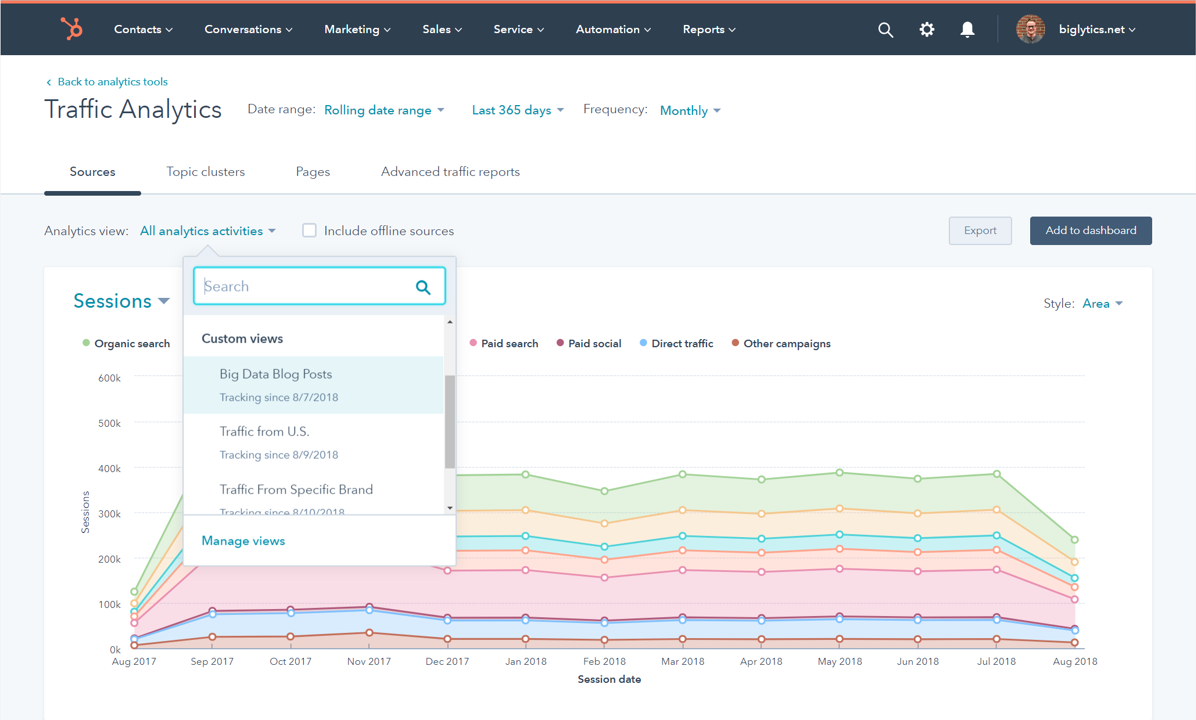
4. BuzzSumo: Tap Into the Power of Viral Content and Trending Topics
BuzzSumo enables you to tap into current content marketing trends. It can help you identify popular topics, look at what resonates with your audience, and even search potential influencers for collaboration.
BuzzSumo’s strength lies in its ability to analyze content performance across social media and the web. Here’s how it can empower your content marketing strategy:
- Trend Identification: BuzzSumo acts like a radar, picking up on emerging trends and popular topics within your niche. This allows you to create timely content that aligns with what your audience is already engaging with.
- Competitor Analysis: Want to know what’s working for your competitors? BuzzSumo lets you see their top-performing content, analyze their social media strategies, and even identify key influencers in your industry.
- Content Ideation: Say goodbye to writer’s block! BuzzSumo provides a wealth of content ideas based on real-time data. You can discover trending keywords, analyze popular content formats, and even see the questions your target audience is asking online.
When looking for more than just basic website data, BuzzSumo may be a good option. This platform goes beyond basic analytics, offering a suite of features designed to help you uncover viral content ideas, track competitor strategies, and amplify your brand’s reach.

5. Buffer: In-Depth Social Media Analytics
Buffer is an intuitive social media management platform with robust analytics features. For agencies and marketers, Buffer helps streamline social media workflows and provides valuable insights into content performance across multiple platforms.
Buffer excels in generating detailed reports based on custom-tailored metrics to align with your business’s specific requirements and goals. It’s akin to having a dedicated analytics assistant at your disposal, minus the exorbitant cost. You can create relevant content by seeing which of your social media channels drive the most engagement.
Let’s explore some key features of Buffer’s analytics capabilities:
- Engagement Metrics: Track likes, comments, shares, and clicks to understand which posts resonate most with your audience. This data helps shape future content strategies and optimize for higher engagement.
- Optimal Posting Times: Buffer analyzes your audience’s activity patterns to determine the best times to post for maximum visibility and engagement. This feature takes the guesswork out of scheduling and helps maximize your organic reach.
- Audience Growth Tracking: Monitor your follower growth across platforms to assess the effectiveness of your social media campaigns. Track how your follower count changes over time and identify trends or spikes in growth.
- Automated Reporting: Generate comprehensive reports on your social media performance with just a few clicks. These reports are easy to share with your team and stakeholders, providing a clear picture of your progress and ROI.
Buffer’s analytics dashboard presents this data in an easy-to-digest format, allowing you to quickly identify areas for improvement and make data-driven decisions. By leveraging these insights, you can refine your social media strategy, tailor your content to your audience’s preferences, and ultimately drive better results for your clients or your brand.

6. Hotjar: See How Your Audience Behaves
Want to know how people really use your website? Hotjar provides deep insights into user behavior and optimizes your content for better engagement and conversions. It’s more than just analytics; it’s a window into the customer journey.
Hotjar is known for its visual tools that go beyond standard metrics. Here’s how it helps you see your website through your audience’s eyes:
- Heatmaps: See where users click, scroll, and move their mouse, revealing areas of interest and potential friction points. This visual representation is key for understanding content engagement and improving user experience.
- Recordings: Watch actual user sessions to see how visitors navigate your site, where they get stuck, and what causes hesitation. These recordings offer invaluable insights for optimizing design and content flow.
- Feedback Forms: Gather direct feedback from users through targeted surveys and polls. Understand their needs, preferences, and pain points to tailor your content strategy effectively.
By combining these powerful features, Hotjar empowers you to move beyond assumptions and make data-driven decisions to create a website that truly resonates with your target audience.
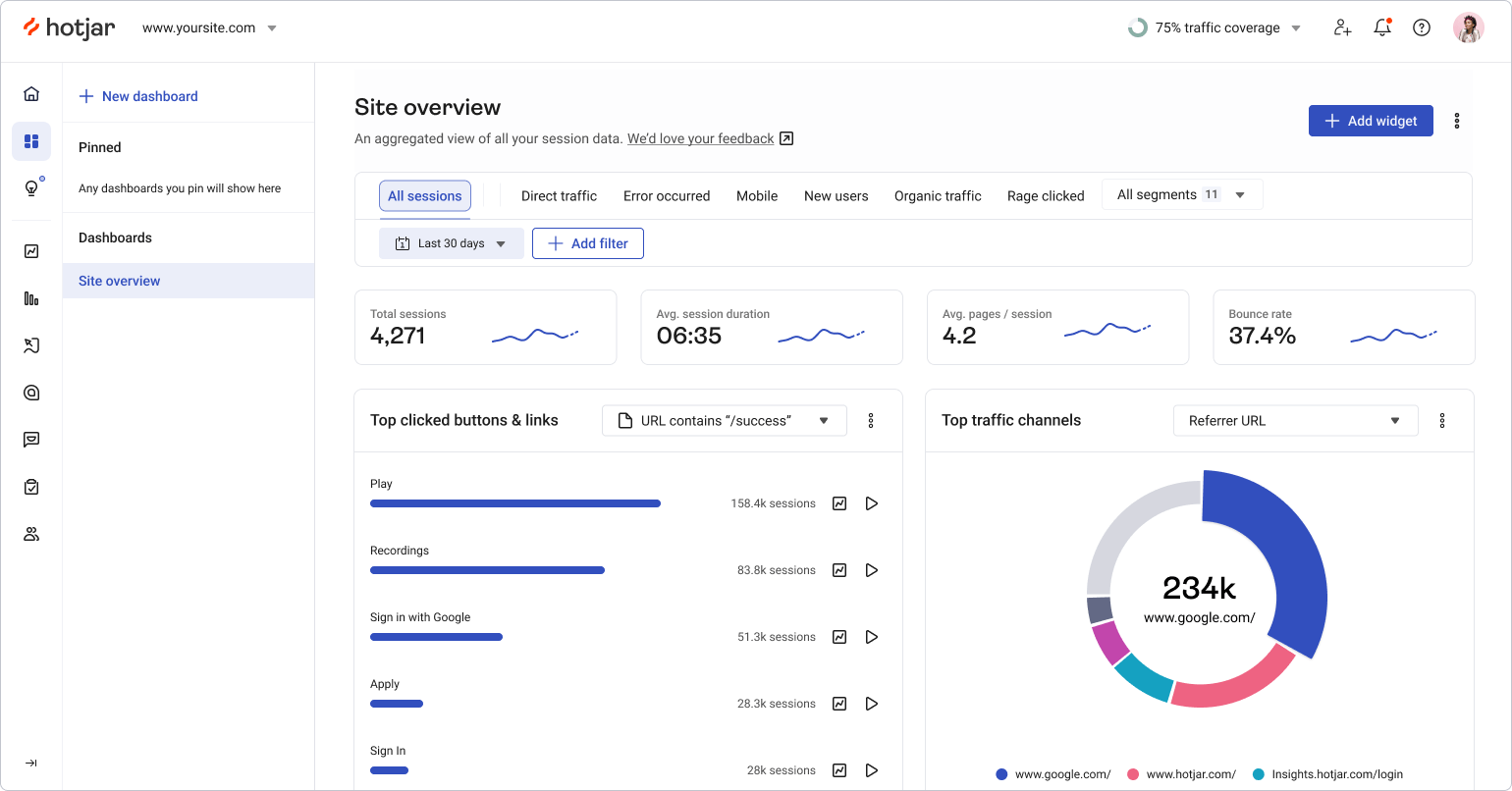
7. Kissmetrics: User-Centric Insights and Content Performance Tracking
Kissmetrics is a powerful analytics tool designed to provide marketers with deep insights into customer behavior across websites and apps. Its standout features make it an ideal choice for measuring the effectiveness of content marketing strategies by tracking individual user journeys and linking content performance directly to business outcomes.
Here’s what Kissmetrics can do for you:
- User-Centric Tracking: One of Kissmetrics’ most valuable features is its ability to track individual user behavior across multiple touchpoints. Unlike traditional analytics tools that focus on aggregate data, Kissmetrics provides a detailed, user-centric view, allowing marketers to see how specific content influences a user’s journey from initial interaction to conversion.
- Cohort Analysis: Kissmetrics offers powerful cohort analysis tools, enabling marketers to segment and track groups of users based on specific behaviors or attributes. This feature is particularly useful for understanding how different segments engage with content over time. Marketers can measure how new versus returning users respond to different types of content, assess the impact of content on user retention, and gain insights into customer behavior that can inform future content creation and targeting.
- Funnel Analysis: Kissmetrics’ funnel analysis helps marketers visualize the journey users take from discovery to conversion. By mapping out the steps a user follows, marketers can pinpoint where users drop off and which content is most effective at guiding users through the sales funnel.
- Retention and Lifetime Value Metrics: Kissmetrics focuses not only on immediate engagement but also on long-term user retention and lifetime value (LTV). By tracking how content impacts customer retention over time, Kissmetrics helps marketers understand which types of content foster deeper relationships with customers. Meanwhile, LTV metrics allow marketers to gauge the long-term success of their content strategies, ensuring that content investment is yielding sustainable value for the business.
- Custom Reports and Dashboards: With Kissmetrics, you can create custom reports and dashboards tailored to specific content marketing goals. Customizable reporting means that teams can streamline their workflow and focus on actionable insights, making it easier to iterate and optimize content strategies efficiently.
Overall, Kissmetrics provides a comprehensive suite of tools that enable marketers to understand the true impact of their content, optimize their strategies, and drive better results.

8. Heap Analytics: Effortless Data Tracking for Deeper Customer Insights
Heap Analytics helps you understand what users do on your site so you can improve your content marketing.
Let’s say someone visits your website but doesn’t click on anything. That’s a problem, right? Heap Analytics can show you this! You can see where people are getting stuck.
Once you know what’s wrong with your content, you can start to fix it. Then you can get more leads.
Heap can also help you understand your audience better. You can see which blog posts are the most popular and which topics people care about. This is really helpful for planning your content marketing strategy.
Heap integrates with other marketing tools too, which makes it easier to track your results and see what’s working.
One of the standout features of Heap Analytics is automatic data capture, which tracks every user interaction without needing manual tagging or setup. This saves a lot of time and ensures you have a complete picture of how users engage with your content — whether they’re clicking, scrolling, or filling out forms. You can then dive deeper into the data with Heap’s powerful user journey mapping and conversion funnels, helping you identify what content drives engagement and where users drop off.
The platform also offers great tools like cohort analysis and retention tracking, so you can see how different audience segments interact with your content over time. This allows agencies to tailor content strategies based on user behavior and keep people coming back for more.
On top of that, Heap’s real-time dashboards and A/B testing support give you the flexibility to make quick adjustments and optimize your content on the fly, ensuring your campaigns stay responsive and effective. It’s an all-in-one solution that helps agencies create data-driven, impactful content strategies.

9. Similarweb: Unlock Competitive Insights and Drive Smarter Growth
Next on our list is Similarweb which is an incredibly useful tool for agencies that want to level up their content marketing analytics.
One of its standout features is its ability to provide deep insights into website traffic, not just for your own site but for competitors as well. You can track metrics like visitor volume, traffic sources, and even user engagement (like time on site or bounce rates), which gives you a clear idea of what’s working in your content strategy and what might need tweaking.
Plus, being able to compare your performance with industry benchmarks or competitors helps you identify opportunities for growth and stay ahead of the competition.
Another great feature is Similarweb’s audience analysis, which breaks down user demographics and interests, showing where your traffic is coming from and who’s engaging with your content. For agencies, this is gold — understanding your audience better means you can create more targeted and personalized content that resonates.
Further Reading: How to Analyze Your Audience to Create Targeted Content
Similarweb also displays keyword and referral traffic data to help you fine-tune your SEO and partnership strategies.
With all this actionable data at your fingertips, agencies can make smarter, more informed decisions that lead to better results for their clients.
10. BrandWell: All-In-One Content Analysis and Optimization Platform
Now you might be wondering, “Jeff, what does a content creation powerhouse like BrandWell have to do with content analytics?”
Here’s what makes BrandWell so special: it simplifies the content analysis process by analyzing your website content, identifying low-quality pages, and offering actionable recommendations for improvement — in just one click.
How does this work? Let’s say you have a new client whose website is lagging in ranking position and traffic. You log into your BrandWell dashboard and create a new project for them. Once you enter their URL, BrandWell will crawl their entire website, build a comprehensive brand graph, and analyze what their website is about – including how they write their content and what’s missing.
Watch this video to see how easy it is to audit your client’s website content:
After running full audits, BrandWell will connect to Google Search Console and find posts to update and rewrite. This allows you to improve existing content or branch out into deeper authoritative topics to boost your client’s positioning at the top of their industry. All these straight from a URL!
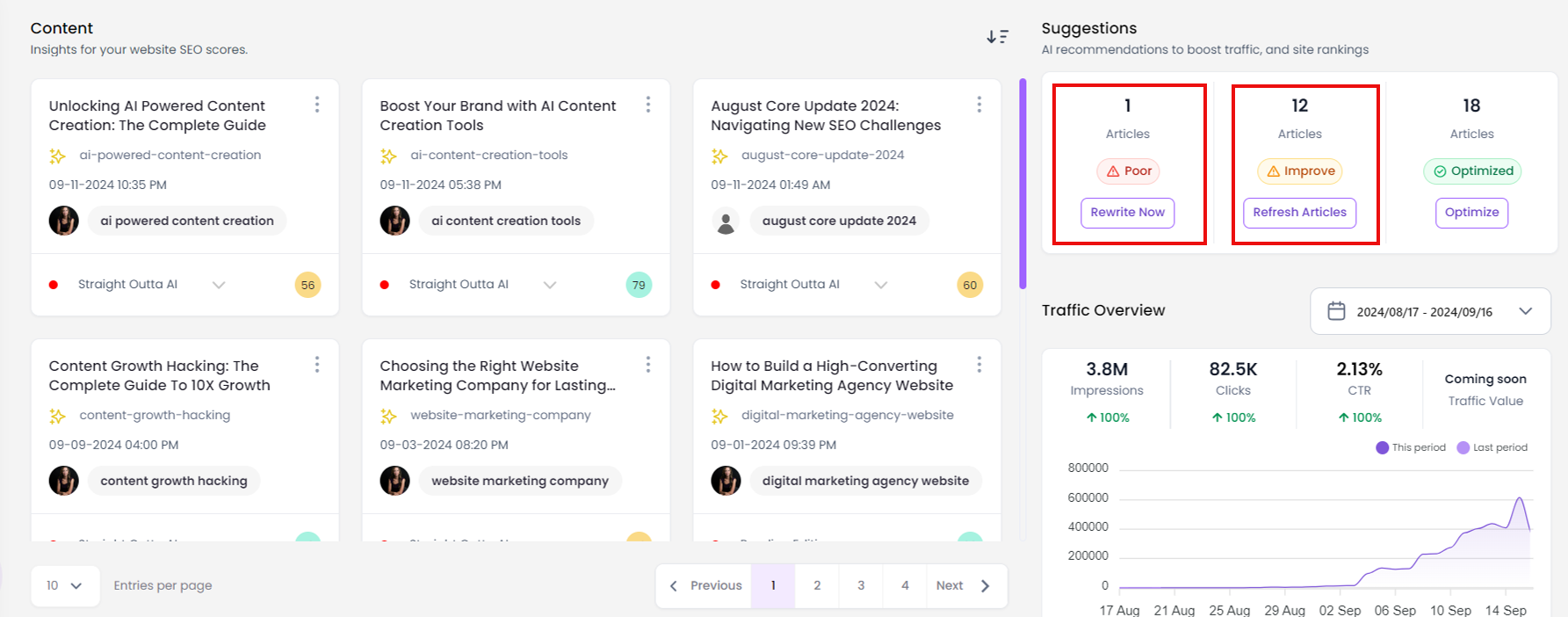
Here’s a closer look at BrandWell’s distinct advantages:
Content Quality Analysis: Evaluates factors influencing readability and reader engagement.
Competitor Benchmarking: Compares your content’s performance against competitors. You’ll get detailed analytics to see where you stand.
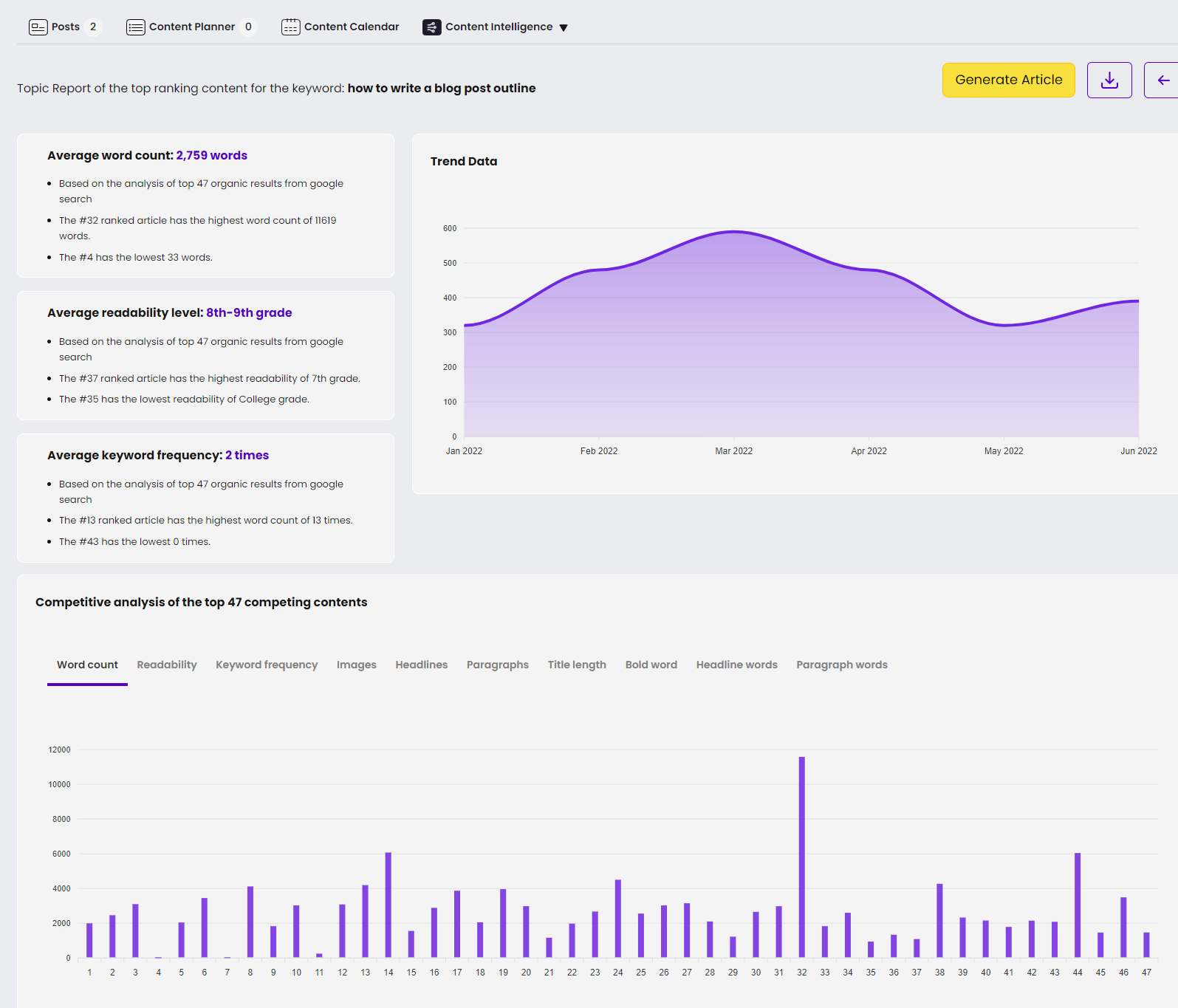 SEO Insights and Optimization: Identifies SEO issues and offers actionable recommendations.
SEO Insights and Optimization: Identifies SEO issues and offers actionable recommendations.
Content Strategy Development: Offers data-backed suggestions for creating resonant content.
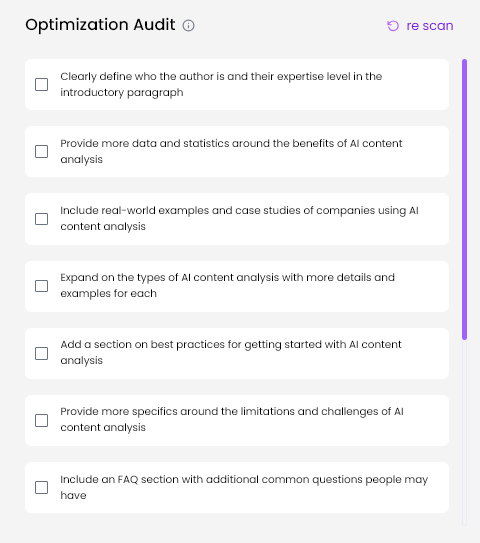
Beyond standard analytics dashboards, BrandWell empowers you to enhance your content actively. It pinpoints areas for improvement and provides prompt solutions.
BrandWell eliminates the need to juggle multiple tools or manually go through every piece of content on your client’s website to gain a comprehensive view of their content performance. This software helps you figure out what’s working, what’s not, and how to fix it.
With content intelligence now a core of BrandWell, it has evolved into a complete solution for creating content that drives results.
BrandWell’s AI analyzes critical factors like keyword performance, content structure, and competitor benchmarks to help agencies fine-tune their strategies. This optimization capability means that you don’t just get well-written, SEO-friendly content; you also get actionable data on how that content is resonating with audiences and impacting overall website performance.
With these analytics, you can continuously improve and adapt your content to ensure maximum visibility and relevance, making it easier to achieve long-term SEO success for your clients.
Elevate Your Client’s Brand in 2025 With These Content Marketing Analytics Tools
The best content marketing analytics tool ultimately depends on your business’s unique needs, goals, budget, and the tech you’re already using. Don’t be afraid to try out different options and see what works best for you.
Finding the right fit can completely transform your content marketing approach, helping you make smarter, data-driven decisions that lead to better results. It’s a key part of any successful digital marketing strategy.

UNLOCK YOUR POTENTIAL
Long Headline that highlights Value Proposition of Lead Magnet
Grab a front row seat to our video masterclasses, interviews, case studies, tutorials, and guides.



